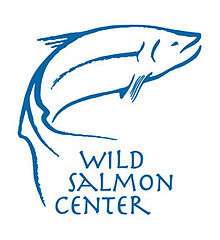Wild Salmon Center
 | |
| Formation | 1992 |
|---|---|
| Type | nonprofit organization |
| Headquarters | Portland, Oregon |
Region served | Northern Pacific Rim[1] |
Staff | 20 |
| Website | www.wildsalmoncenter.org |
The Wild Salmon Center (WSC) is an international conservation organization that works to protect wild salmon, steelhead, char, trout and the ecosystems on which these species depend.[2] Headquartered in Portland, Oregon, United States, the WSC works with communities, businesses, governments, and other non-profits to protect and preserve healthy salmon ecosystems in the North Pacific.[3] WSC programs range in location from Russia, Japan, Alaska, British Columbia, Washington State, Oregon, and California.
Background
The WSC was founded as a non-profit by Pete Soverel and Tom Pero in 1992, and was run entirely by volunteers during its first five years. Originally the WSC received funding for research and conservation through organizing angling trips to the Kamchatka Peninsula in the Russian Far East. These expeditions were a joint venture between the WSC and Moscow State University. In 1998, WSC hired Guido Rahr as Executive Director, formerly with the conservation organization Oregon Trout, where he developed an approach to salmon conservation that focused on proactive protection of the strongest remaining populations (stronghold strategy). The organization expanded rapidly between 1999 and 2010. A new organization called The Conservation Angler was created in 2003 to take over the ecotourism programs, allowing the WSC to focus solely on science and conservation.[4] One of the WSC programs, State of the Salmon, a science-based program created in 2003 in collaboration with Ecotrust, used data to track the health and trends of wild salmon populations. This data was then analyzed, and used to inform salmon management and conservation throughout the Pacific Rim.[5] While State of the Salmon has concluded, sustainable fisheries work continues with a new organization, Ocean Outcomes, which was incubated and launched by Wild Salmon Center in 2015.[6] Ocean Outcomes is a global fishery improvement organization targeting high risk fisheries - the fisheries that face the biggest conservation challenges and have the most to gain from improvements. O2 works hand-in-hand with commercial fisheries and local communities to improve the sustainability of global fisheries.
Stronghold Strategy
Adopted in 1999, the WSC has been focused on a proactive "salmon stronghold" conservation strategy as a regional and international approach to salmon conservation.[7] Salmon strongholds refer to river ecosystems that contain the most abundant and biologically diverse populations of wild salmon. Select areas on the Kamchatka Peninsula, Sakhalin Island, and the Russian Far East mainland, as well as key watersheds in the lower 48 US States, British Columbia, Bristol Bay and much of Alaska are considered salmon strongholds .[8] As part of its efforts to protect habitat in Oregon, the Wild Salmon Center is a member of the North Coast State Forest Coalition. In identifying and then protecting salmon strongholds, the WSC aims to conserve healthy salmon stocks before they decline and ensure sustainable fish populations survive for the long term.[9]
Accomplishments
· Eight million acres in protected status, including public lands designations, new parks or other protected areas, and land acquired by partners that either wholly or partly financed by Wild Salmon Center.
· 12,000 river miles of expanded riparian protection (either beyond regulatory baseline or by raising the regulatory baseline). This includes areas within the eight million acres in protected states as well as 2,500 river miles in western Oregon through expanded riparian buffers on state and private land.
· Founded or co-founded thirteen new and currently operating organizations and coalitions: Hoh River Trust (Washington), Russian Salmon Fund (Moscow), Ocean Outcomes (Portland/Japan), Conservation Angler (Washington), Washington Coast Sustainable Salmon Partnership (Washington), North Coast State Forest Coalition (Oregon), IUCN Salmon Specialist Group (International), Sakhalin Wild Salmon Territory, and five watershed councils in Russia: Smirnykh (Sakhalin) Yelisovo (Kamchatka), Bolshaya (Kamchatka), and Kopi (Russia Far East).
· 50+ exchanges between US and Russian and Canada and Japan. Three international salmon conservation conferences.
· Over 70 peer reviewed scientific studies published in the US, Japan and Russia;
· Four salmon fisheries certified by the Marine Stewardship Council or engaged in a Fishery Improvement Project (now with Ocean Outcomes).
· 25 watersheds or sub watersheds in western Oregon managed for wild salmon and steelhead — the largest “wild fish only” network south of Canada.
· Over $100 million in direct grants or funds secured from other public or private sources and directed to our projects and those of our partners.
See also
References
- ↑ Salmon Strongholds. http://www.wildsalmoncenter.org/programs/index.php/
- ↑ Chivers, CJ. The New York Times. "Salmon Find a Surprising..." October 15, 2006
- ↑ "About Us" http://www.wildsalmoncenter.org/about/index.php accessed on: 05/05/11
- ↑ Stanford: Graduate School of Business. "The Wild Salmon Center" May 28, 2003
- ↑ State of the Salmon. accessed on: 05/15/2011
- ↑ http://wildsalmoncenter.org/2015/02/10/ocean-outcomes/
- ↑ The Oregonian. 'Wild Salmon Center wants to Redirect..." September 7, 2008.
- ↑ Oceanography. "Salmon Strongholds" September 2010 Vol. 23/3 P.14
- ↑ Programs. Wild Salmon Center: accessed on: 05/16/2011